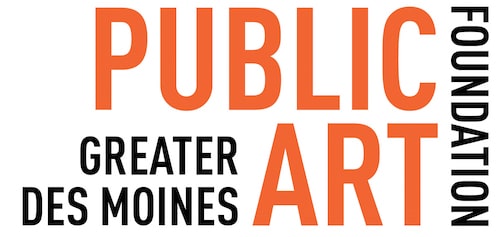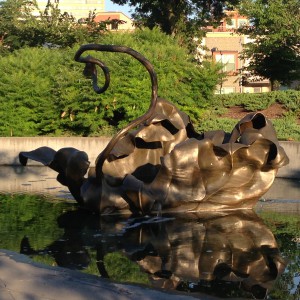
Greater Des Moines Public Art Foundation
Educational and Family Resource
Quantum Leaf
Quantum Leaf is 15 feet in diameter and 11 feet in height. It resembles an oversized dying leaf with its edges curled. It is placed in a fountain with water pouring from the leaf into a circular pond. It is designed for a park-like setting north of the former Downtown YMCA in Des Moines.
Sally Pettus was born in March of 1942. She studied at The Cleveland Institute of Art and Sarah Lawrence College. Quantum Leaf was commissioned by Melva Busksbaum after seeing some of the artist’s sculptures. Of Quantum Leaf the artist has said, “The leaf falls from a tree. It could land on water and die, and then the cycle of life begins again.” This larger-than-life symbol or life’s natural cycle is Sally Pettus’ first large-scale public artwork.
Discussion Questions
- What is your first impression of the sculpture? What details do you notice?
- How would you describe this work of art to someone who cannot see it? Try to be as specific and detailed as possible.
- Why do you think the artist made this piece? What message do you think that she was trying to communicate?
- What about the works physical attributes and/or location supports your hypothesis?
- The artist tells us that this piece is meant to evoke life's natural cycle of death and regeneration. What other ideas might this work invoke?
- What do you find pleasing about this work? What do you find displeasing? If you could change any one thing about it, what would it be and why?
- How does the location of this work affect how you think or feel about it? Can you imagine it anywhere else? How would it look or 'feel' different in a different space? Use your imagination and try to be specific.
Literature
Morteza E. Sohi Look What I Did with a Leaf! New York: Walker, 1993
Provides examples of different kinds of animals that can be made out of leaves and suggests various uses for the finished product. Look What I Did with a Leaf! will show young art and craft lovers how to use nature’s bounty to create fanciful animals and natural scenes. Readers will develop their artistic eye and soon learn to see the artistic possibilities that surround them. Morteza E. Sohi gives careful directions on how to choose leaves for shape and color, how to arrange them in an animal form, and how to preserve the finished work of art. A field guide helps young leaf artists learn more about the tools of their craft.
Lois Ehlert Leaf Man. Orlando, Florida : Harcourt, Inc., 2005
Early childhood and elementary aged children will investigate the travels of Leaf Man, who blows away, traveling wherever the wind may take him. On die-cut pages.
Candace Christiansen & Thomas Locker. Sky Tree: Seeing Science Through Art. New York: HarperCollins, 1995.
A tree stands on a hill by a river, its branches showing the seasons, filling with changing leaves, clouds, snow, birds, mist, fog, and the spring sun. Uncover this lyrical text describing the change of a tree and investigate its path in the discussion questions focused on how art and science are intertwined.
Nancy Willard. Step Lightly: Poems for the Journey. San Diego : Harcourt Brace, 1998.
This collection of poems celebrate the ordinary in an unordinary way, by such authors as Emily Dickinson, Theodore Roethke, and D.H. Lawrence, has been gathered about one woman’s “journey of life.”
Internet Resources
Sally Pettus Website
Visit the Quantum Leaf’s artist website to investigate her other paintings, fountains and bronze sculptures
(Elementary to high school)
Exploring Iowa’s Natural Resources
Use this website to investigate the concept of regeneration through a tree’s life cycle which includes a variety of literature connections for pre-kindergarten through high school
(Preschool to middle school)
Real Kids 4 Trees
Children will find this site helpful for researching trees. Real Kids 4 Trees provides information on lifecycle, types and recycling for art projects.
(Upper middle school to high school)
Ecology in Art Video
Artists explore how our understanding of the natural world becomes deeply cultural
(Upper middle school to high school)
The Concept of Environmental Art
PBS videos for students in which artists explore how our understanding of the natural world becomes deeply cultural. Investigate a program working to promote revitalization through arts and the environment high school
(Upper elementary through high school )
Nature Activities for Young Children
Activities that promote love of nature through various experiences including art for young children.
Smithsonian Everything Art Student Resources and Games
Explore interdisciplinary activities and resources for students of all ages
Artistic Approaches to Ecological Literacy
Article offering suggestions for developing eco-art education in elementary classrooms
Art Activities
The J. Paul Getty Museum Sculptural Space Lesson Plans
Sculptural Spaces lesson plans for middle and high school students addressing the planning and problem solving artists use as they create site specific outdoor sculpture.
The Metropolitan Museum of Arts Environmental Art Lesson Plans
Follow the theme of art and the environment to find a variety of elementary to high school art activities to investigate the connections between art and the environment.
Leaves with Small Hands
Preschool through early elementary school children can investigate leaves using paint, 3-D sculpture and drawing from Art with Anything by MaryAnn F. Kohl.
Art Inspired Environmental Lesson Plans
Elementary through middle school level interdisciplinary lessons to explore art and design to promote a healthy, peaceful and sustainable world.
Environmental Art
Elementary through high school lesson plans involving students creating their own environmental art.
Art & Ecology – Green Museum
A set of resources for teachers and an online exhibition of contemporary ecological art for elementary through high school students
Use Nature to Investigate Science
Preschool children examine sink and float concepts using leafs in this inquiry based activity.

